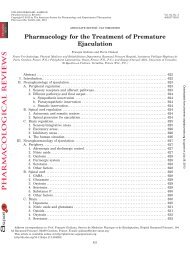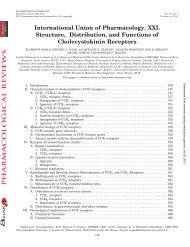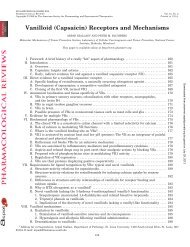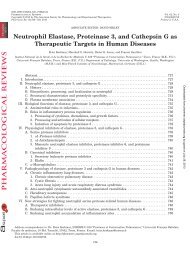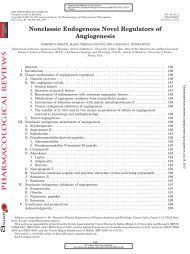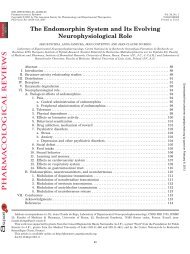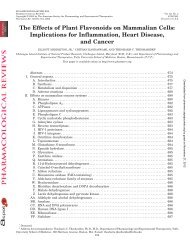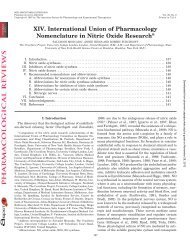Opioids, Reward and Addiction: An Encounter of Biology ...
Opioids, Reward and Addiction: An Encounter of Biology ...
Opioids, Reward and Addiction: An Encounter of Biology ...
Create successful ePaper yourself
Turn your PDF publications into a flip-book with our unique Google optimized e-Paper software.
1994; Smith <strong>and</strong> McGinty, 1994). In addition, increased<br />
dynorphin levels were demonstrated in the substantia<br />
nigra, NAC, but not hippocampus (Sivam, 1989; Smiley<br />
et al., 1990; Trujillo et al., 1990).<br />
Studies on animals self-administering cocaine shed<br />
some more light on the potential involvement <strong>of</strong> -endorphin<br />
in processes underlying cocaine dependence.<br />
Sweep et al. (1988, 1989) found marked decreases in<br />
E-IR levels in the anterior part <strong>of</strong> the limbic system<br />
(i.e., NAC, septum, hippocampus, <strong>and</strong> rostral striatum)<br />
in animals self-administering cocaine. Furthermore, using<br />
an in vivo autoradiographic technique, a decrease in<br />
opioid receptor occupancy was found in restricted subcortical<br />
brain regions <strong>of</strong> animals self-administering cocaine,<br />
including limbic areas (i.e., lateral septum, ventral<br />
pallidum, nucleus stria terminalis, <strong>and</strong> amygdala)<br />
<strong>and</strong> some regions <strong>of</strong> the hypothalamus <strong>and</strong> thalamus<br />
(Gerrits et al., 1999). The decrease in opioid receptor<br />
occupancy is probably due to a release <strong>of</strong> endogenous<br />
opioids in these particular brain regions. Interestingly,<br />
both <strong>of</strong> these changes (i.e., decreased E-IR content <strong>and</strong><br />
increased endogenous opioid release) were present just<br />
before a scheduled next cocaine self-administration session<br />
would have taken place; thus, when the desire or<br />
need for the drug is assumed to be high. This might<br />
suggest an involvement <strong>of</strong> endogenous opioids, <strong>and</strong> possibly<br />
-endorphin, in the processes underlying the need<br />
for cocaine. When the same methodologies were used in<br />
rats that just had completed their daily cocaine selfadministration<br />
session, it appeared that E-IR levels in<br />
the brain were hardly changed <strong>and</strong> that a decrease <strong>of</strong><br />
opioid receptor occupancy was present in many brain<br />
areas, including the NAC (Sweep et al., 1988; Gerrits et<br />
al., 1999). Daunais et al. (1993), investigating the effect<br />
<strong>of</strong> cocaine self-administration on the expression <strong>of</strong><br />
dynorphin mRNA, found an increased expression in the<br />
patch-like areas <strong>of</strong> the dorsal, but not in those <strong>of</strong> the<br />
ventral, striatum. Because repeated high doses <strong>of</strong> cocaine<br />
given for 6 to 7 days were necessary to induce this<br />
effect, the authors concluded that the increased dynorphin<br />
mRNA expression does not underlie the acute reinforcing<br />
effects <strong>of</strong> cocaine but is more associated with<br />
long-term adaptation <strong>and</strong> sensitization.<br />
Besides regulating the level <strong>of</strong> endogenous opioids <strong>and</strong><br />
the expression <strong>of</strong> opioid mRNA in the brain, studies have<br />
demonstrated that psychostimulant drugs also regulate<br />
the density <strong>of</strong> opioid receptors in the brain. Chronic<br />
cocaine exposure reduced opioid receptor density, as labeled<br />
by [ 3 H]naloxone, in the hippocampus <strong>and</strong> striatum<br />
<strong>and</strong> in the basolateral nucleus <strong>of</strong> the amygdala, VTA,<br />
substantia nigra, <strong>and</strong> dorsal raphe nuclei (Ishizuka et<br />
al., 1988; Hammer, 1989). <strong>An</strong> increase in opioid receptor<br />
density was found in the NAC, ventral pallidum, <strong>and</strong><br />
lateral hypothalamus. In light <strong>of</strong> the selective opioid<br />
receptors in the brain, studies were performed with<br />
more selective radiolig<strong>and</strong>s. In short, chronic treatment<br />
<strong>of</strong> rats with cocaine caused an up-regulation <strong>of</strong> -opioid<br />
OPIOIDS, REWARD AND ADDICTION 375<br />
receptors in the cingulate cortex, NAC, rostral caudate<br />
putamen, <strong>and</strong> basolateral amygdala; an up-regulation <strong>of</strong><br />
-opioid receptors in the cingulate cortex, rostral caudate<br />
putamen, olfactory tubercle, <strong>and</strong> VTA; <strong>and</strong> no<br />
change in -opioid receptors in any <strong>of</strong> the brain regions<br />
examined (Unterwald et al., 1992, 1994). Itzhak (1993),<br />
studying the effect <strong>of</strong> chronic cocaine treatment on opioid<br />
receptor densities in guinea pigs, found a significant<br />
down-regulation <strong>of</strong> -opioid receptors in frontal cortex,<br />
amygdala, thalamus, <strong>and</strong> hippocampus; an alteration in<br />
the expression <strong>of</strong> -opioid receptors in the cerebellum;<br />
<strong>and</strong> no significant changes in -opioid receptor expression.<br />
Furthermore, it was shown that “binge” pattern <strong>of</strong><br />
cocaine administration led to significant decreases in<br />
the level <strong>of</strong> -opioid receptor mRNA in the substantia<br />
nigra but not in the caudate putamen (Spangler et al.,<br />
1997). Finally, to determine the functional consequences<br />
<strong>of</strong> chronic cocaine on opioid receptors, Unterwald et al.<br />
(1993) measured changes in adenyl cyclase activity.<br />
They found that chronic cocaine administration resulted<br />
in a selective impairment <strong>of</strong> -opioid receptor-mediated<br />
function in the caudate putamen <strong>and</strong> NAC.<br />
In conclusion, a role for -opioid receptors <strong>and</strong> endorphin<br />
in cocaine dependence seems likely. This role<br />
may be at the level <strong>of</strong> modulating the reinforcing action<br />
<strong>of</strong> cocaine <strong>and</strong> the motivational state induced by repeated<br />
cocaine exposure. Concerning the - <strong>and</strong> -opioid<br />
receptors <strong>and</strong> the dynorphin <strong>and</strong> enkephalin systems,<br />
the data so far do not allow definitive conclusions. In<br />
particular, it is not clear how to link effects <strong>of</strong> passive<br />
administration <strong>of</strong> cocaine with the addiction, e.g., selfadministration<br />
process.<br />
B. Ethanol<br />
In 1970, a biochemical link was proposed between<br />
ethanol <strong>and</strong> opioid systems based on the finding that<br />
condensation <strong>of</strong> the ethanol metabolite acetaldehyde<br />
<strong>and</strong> biogenic amines produced tetrahydroisoquinolines<br />
(TIQs). These TIQs seemed to have opioid-like effects<br />
(Davish <strong>and</strong> Walsh, 1970; Cohen <strong>and</strong> Collins, 1970; Fertel<br />
et al., 1980). Long-term ethanol self-administration<br />
induced the formation <strong>of</strong> TIQs in the brain <strong>of</strong> rats (Collins<br />
et al., 1990; Haber et al., 1996). Furthermore, TIQs<br />
induced excessive alcohol drinking, an effect that was<br />
modulated by morphine <strong>and</strong> naloxone (Critcher et al.,<br />
1983). Evidence for an involvement <strong>of</strong> the endogenous<br />
opioid systems in ethanol reinforcement <strong>and</strong> addiction is<br />
provided by studies with opioid antagonists <strong>and</strong> agonists<br />
(for reviews, see Herz, 1997; Spanagel <strong>and</strong> Zieglsgängsberger,<br />
1997).<br />
Opioid antagonists, such as naltrexone <strong>and</strong> naloxone,<br />
decrease ethanol self-administration in rodents <strong>and</strong><br />
monkeys under a variety <strong>of</strong> different experimental conditions.<br />
Although opioid blockade by antagonists blocked<br />
intragastric (Sinden et al., 1983) <strong>and</strong> i.v. (Altshuler et<br />
al., 1980; Martin et al., 1983) self-administration <strong>of</strong> ethanol,<br />
the majority <strong>of</strong> studies on the involvement <strong>of</strong> en-



